
Firefighters, like those working the Ranch2 Fire in Azusa (smoke seen in this photo) have a list of things they need to do in order to safely fight these types of blazes.
By Charly SHELTON
There have been 5,762 wildfire incidents this year, according to Cal Fire. These fires are responsible for burning an estimated 204,481 acres and damaging or destroying 181 structures including houses. And with fire season already underway, this number will continue to grow as temperatures linger in the 90°s, at least through the end of the month with no rain in sight. Hot weather breeds more fires. But firefighters can’t let a little heat prevent them from getting on the front lines of saving lives and property.
“Hydration is the key,” said Capt. Ron Hillson, who has spent 28 years with LA County Fire. “Hydrate before you show up [to the fire].”
He added that dealing with high temperatures due to weather is part of the firefighters’ training. Running with 50 pounds of gear can be strenuous in even the mildest spring weather, let alone the 100° or above conditions of the last few weeks. This is not something that firefighters take lightly, Hillson said. Their workouts prepare them to be able to shoulder a pack in even the hottest conditions.
“You can’t just show up and go out hiking up mountains,” Hillson said. “You have to incorporate exercise, cardio and stretching.”
In addition to the workouts and training, firefighters always check weather conditions and, when it is going to be really hot, they do things like minimize their intake of caffeine and sugary beverages. But the most important aspect in fighting fires in hot weather is simple – “Know your limits,” Hillson said.
It is up to the incident commander to know the limits of the crews. The crews are rotated and cooling stations are set up to quickly vent heat. Depending on how hot it is, sometimes firefighters have to take off their gear and submerge their hands and arms in ice water for a quicker cool-off.
Whether it’s avoiding sugary drinks, hydroloading or an ice bath for the tired arms of an overbaked firefighter, it is just a day in the life of a first responder on the front lines of keeping the public safe.
